It seems like everything is outrageously expensive nowadays, from the prices of new cars to rates at public charging stations. If you’re looking to escape the squeeze, I just found a car that claims to get as good gas mileage as a small motorcycle. This is the XR-3, and it’s somehow the best and the most shocking car-thing that you’ll see in a while. It has a turbodiesel engine and gets 125 mpg, but just look at it.
Amazingly, this car was not exactly a one-off, but a kit car, and it’s somehow even crazier than the lede suggests. The XR-3 was marketed as a diesel-electric plug-in hybrid. When equipped as a hybrid, this thing is supposed to get a combined 225 mpg.
I have found what appears to be the only XR-3 for sale in America out of who knows how many were ever built, and I’m sort of shocked at the whole thing. This car is like a homebuilt version of the Volkswagen XL-1, but with a body closer to that of the HMV FreeWay and a top speed apparently as high as 80 mph. Let’s jump into it!

Creator Of Many Things
The XR-3 was the work of Robert Q. Riley Enterprises, LLC., a green vehicle company located in Glendale, Arizona. Chances are, if you’ve read Popular Mechanics or Mechanix Illustrated at any point in the past half-century, you’ve seen one of mechanical engineer Robert Q. Riley’s ideas, and oh my, he had lots of them. Let the folks of 3-Wheelers.com bring you up to speed:
Robert Q. Riley Enterprises was founded in 1986 by Robert. Q. Riley as a Design Consultancy who specialise in Product design and development. Along with a number of other innovations the company has also created a number of 3-wheelers that are sold as plans ready for the owner to build them selves completely from scratch.
The first of these was the Trimuter, this first appeared on the cover of Mechanix Illustrated magazine in February, 1980 and was also used as a back ground vehicle in the film Total Recall. The Trimuter is powered by either an electric engine or a 16-hp, two-cylinder industrial engine. (The electric version uses ten 6v batteries) The body is a fibreglass / urethane foam composite and houses a two seater cabin.
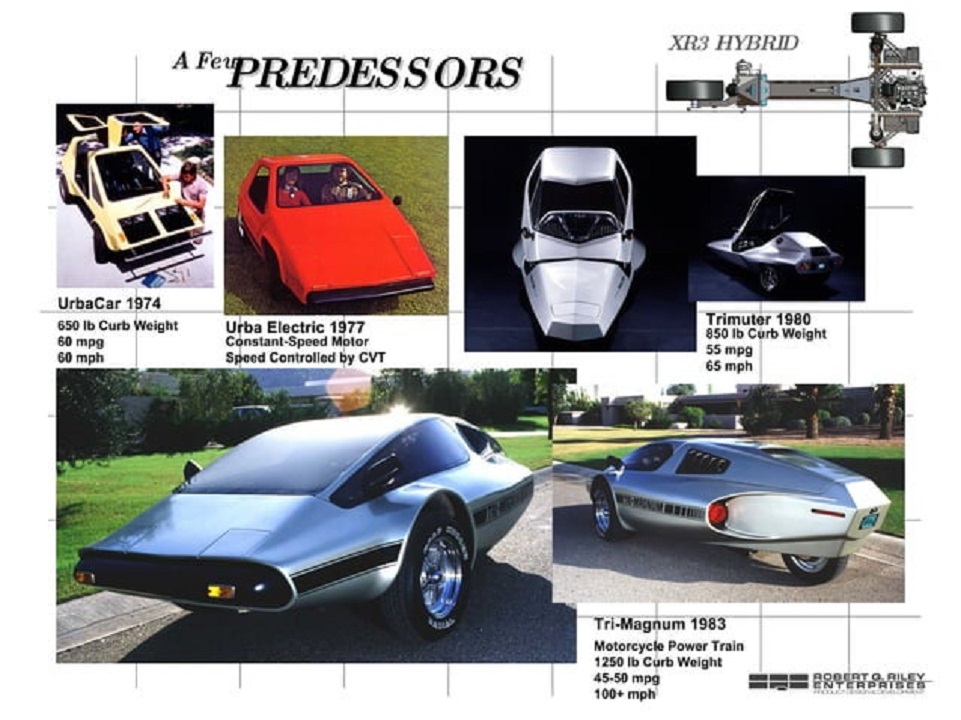
The Tri-Magnum which was designed as a high performance 3-wheeled sports car and was first featured in Mechanix Illustrated magazine, February 1983. The original Tri-Magnum was powered by a Kawasaki KZ900 motorcycle engine though this has now been changed to the Honda Gold Wing engine as this features an electric reverse facility. The chassis of the Tri-Magnum is a stripped motorcycle chassis minus the fork and front wheel. This is then attached a VW Beetle front suspension assembly using a simple framework. The body is a “sandwich” of urethane foam and fiberglass bonded together and houses a two seater cabin with seats side by side. In addition it also features a lift up canopy which has a steel framework embedded into it. Steering is via handlebars whilst gear change is by a “jet-fighter-style control stick” that emerges from the floor.
Riley was known best for his trikes, one of which I have written about before, but his scope was far greater. As a biography on his now-offline website says, Riley designed GM’s Drive I electric car in addition to boats, kit-built single-person submarines, a camper van, a backpack helicopter, and even a homebuilt hovercraft.
The XR-3 Hybrid

Riley wasn’t just a dreamer, either, as these kits were sent out into the wild, and people have built them. Sadly, Riley passed in 2021. He was still working and dreaming when he passed, and one of his projects was the XR-3, a trike that he had been developing since the mid-2000s. How old is the XR-3 project? Mike Spinelli wrote about it on Jalopnik in 2007!
Back then, here’s the press release that Riley sent out:
Fuel-Efficient XR-3 Will Offer 125-225 Miles per Gallon
In less than 90 days, Robert Q. Riley Enterprises, LLC, a product design firm in Glendale, Ariz., will introduce its XR-3 plug-in hybrid, a sleek two-passenger, three-wheel sports car that is expected to generate up to 225 miles per gallon. Designed to be assembled by someone with average mechanical abilities and no prior experience, the all-wheel drive vehicle will be available as a kit or plans for complete do-it-yourself construction.
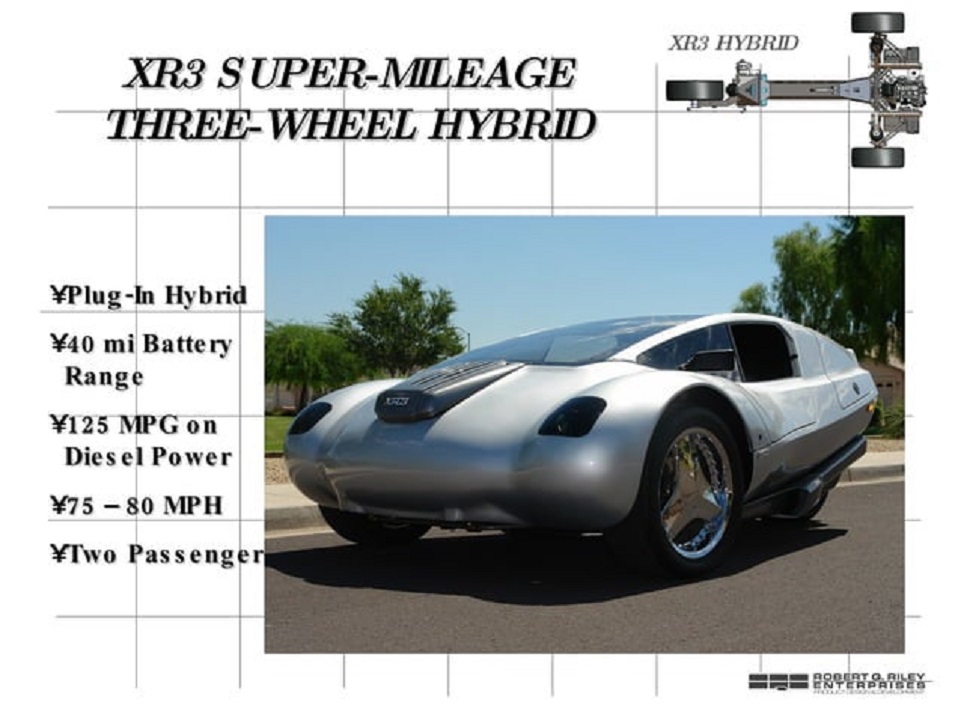
“We’ve made a technology leap by designing a super-simple hybrid power system, but ‘technology’ itself was not the main thrust of the project,” said Robert Q. Riley, company president and author of “Alternative Cars in the 21st Century.” “We focused on the power of ‘design’ to define a new category of personal mobility products that are neither automobiles nor motorcycles.” The XR-3 uses the latest hybrid power system technologies in the most simplified way possible. While the front wheels are powered by a three-cylinder diesel engine, a single rear wheel uses an electric motor run by a lithium-ion battery. The ground provides the connection between the two systems, eliminating the need for a complex electronic and mechanical interface.
Driving on power from its diesel engine, the XR-3 can achieve fuel economy of 125 miles per gallon. However, when the diesel and electric power systems are combined in a hybrid driving mode, fuel economy can exceed 200 miles per gallon over an 80-mile trip. A simple three-position switch allows the driver to select between battery-only, diesel-only and hybrid driving modes. The diesel engine can remain off for local trips, since power from the advanced lithium-ion battery pack gives the car a battery-only range of up to 40 miles.
While the XR-3 was marketed as a hybrid, it was really a vehicle with two completely separate powertrains that do not interact with each other. If you built the base car, you fitted your XR-3 with Kubota D902, a 898cc three-cylinder diesel good for up to 24.8 HP depending on exact configuration. This engine transmitted power to the front wheels through a VW Type 1 transaxle.

If you wanted to go all the way, Riley also marketed the XR-3 as having the option to sport lead-acid batteries or lithium batteries, which would power an eight-inch DC motor that drives the rear wheel. As a diesel-only vehicle, Riley said, you’d get 125 mpg. Add the electric motor and batteries, and Riley said you’d hit 225 mpg. He also said that if you built the diesel version with a large enough fuel tank, you could go 1,000 miles per tank. On the other hand, if you went with a big lithium battery, Riley said, you could get the trike to go 100 miles per charge.
Riley also said that if you built your trike as a diesel-only car, it would weigh 950 pounds. But as a hybrid with the electric motor, batteries, and the diesel engine, the total weight was projected to be 1,480 pounds. The average specification, Riley mentioned in press releases, would be able to travel 40 to 50 miles on a charge, or 375 miles on only three gallons of diesel. In 2008, the batteries were said to be able to recharge in 8 hours. Today, the company that sells the kit says that an XR-3 trike with a modern lithium battery can charge to 80 percent in less than an hour.
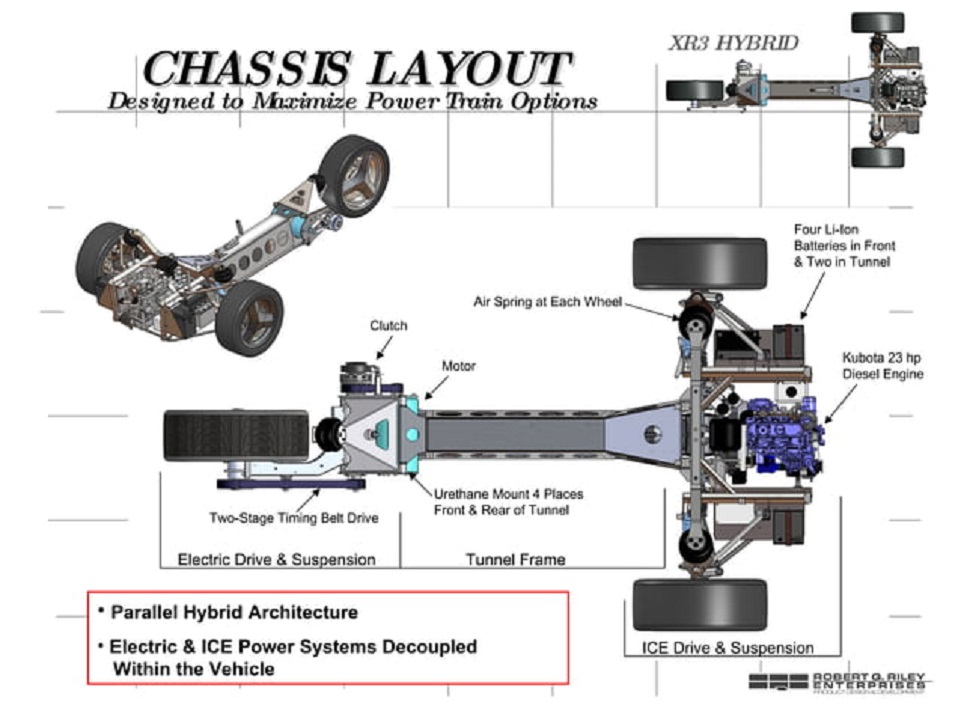
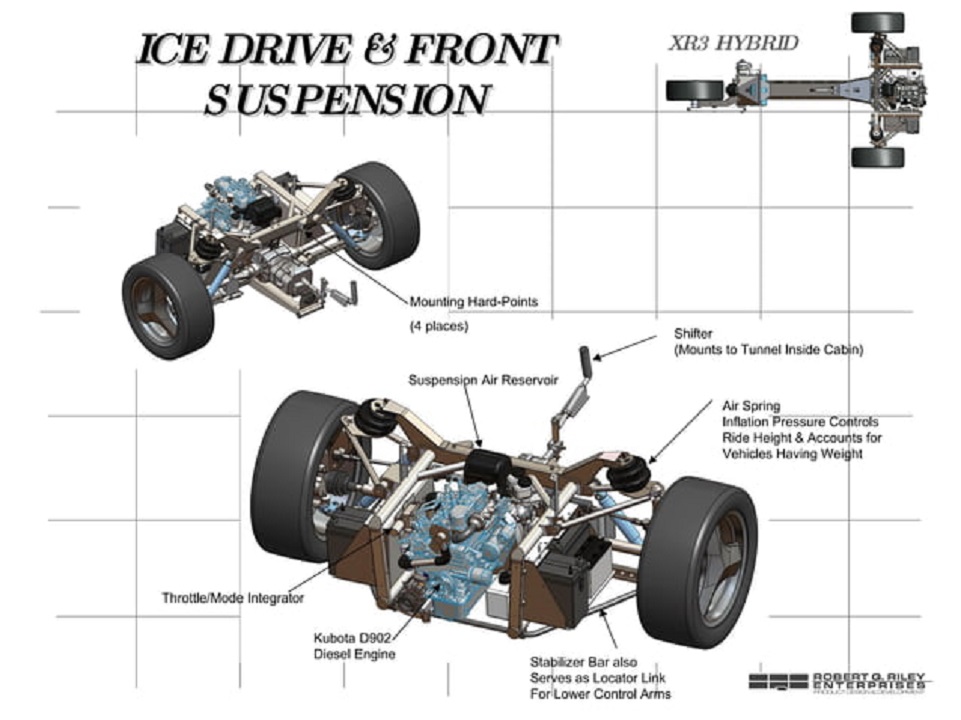
Riley and his team built a single prototype in 2008 and began marketing the XR-3 as a kit car or as a turn-key car that you could buy. Apparently, the guys who built the body of the prototype had never even worked with fiberglass before. According to the press material, anyone with basic construction skills should be able to complete an XR-3, and it should take about 650 hours to finish the build. Riley said that it cost $25,000 to build the prototype, which had lithium batteries and a diesel engine. In 2010, he estimated that a compatible lithium battery would cost $9,000, while an alternative equivalent lead-acid solution could be $2,000.
So then, you’re probably wondering why the XR-3 on your screen today looks nothing like the prototype.
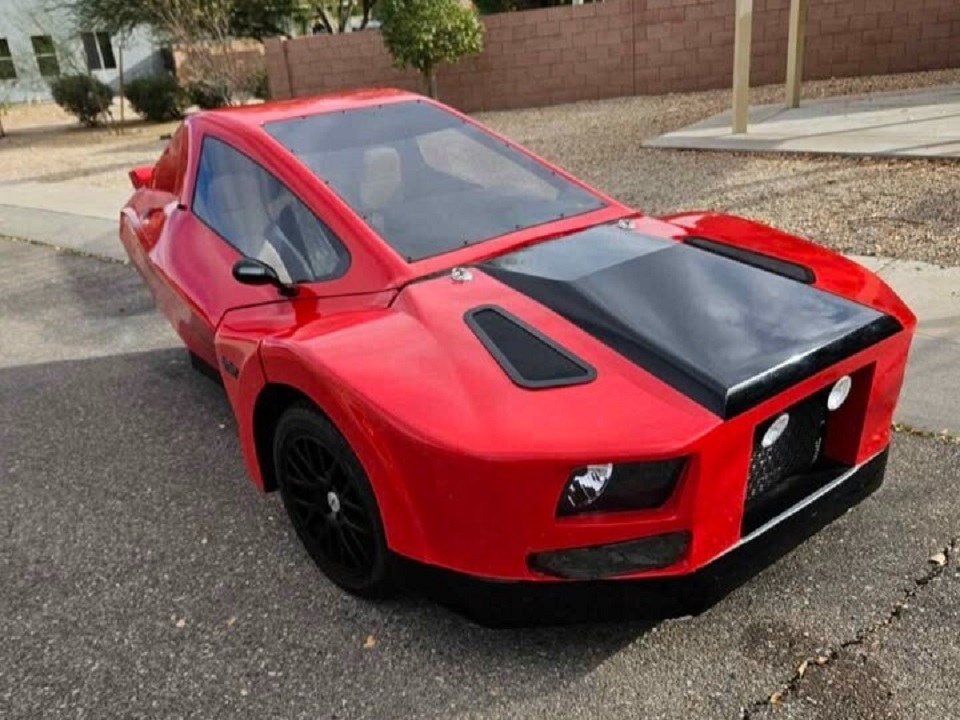
After all, Riley’s idea was that you could buy the whole body and maybe even the vehicle’s steel frame if you wanted to, so you wouldn’t have to mess around with fiberglass or make your own structure. 3-Wheelers.com interviewed Riley and found out that Riley was $25 million short of putting the kit into production. In the meantime, Riley sold plans and instructions to build your own XR-3 on his website.
Unfortunately, Riley passed before these parts could enter production. So, if you buy plans and instructions, you’re entirely on your own for the end result.
This XR-3
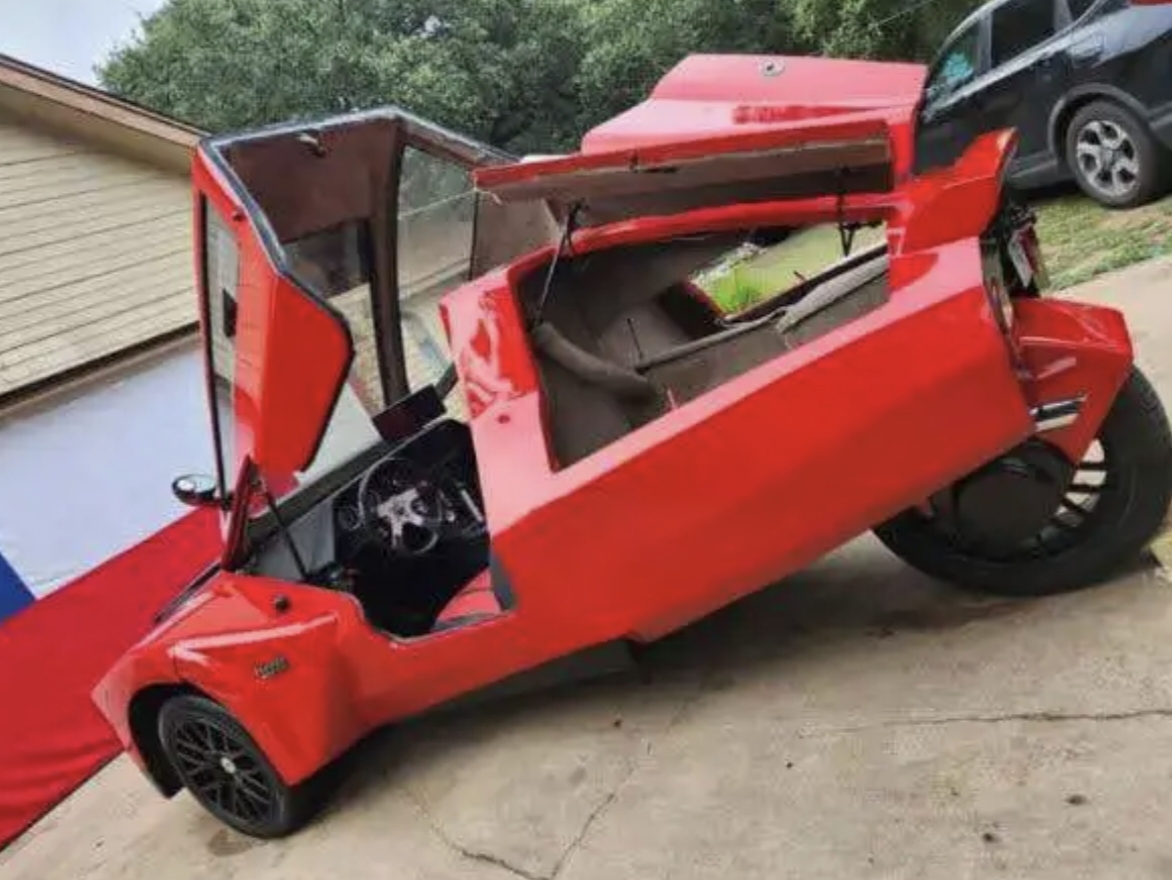
That brings us to the 2019 XR-3 that’s for sale on Facebook.
As you can tell, it looks nothing like the prototype. It’s also somewhat short on the features of the prototype. This one isn’t rocking the dual drivetrain, but instead has just the Kubota diesel, which is spinning the front wheels.
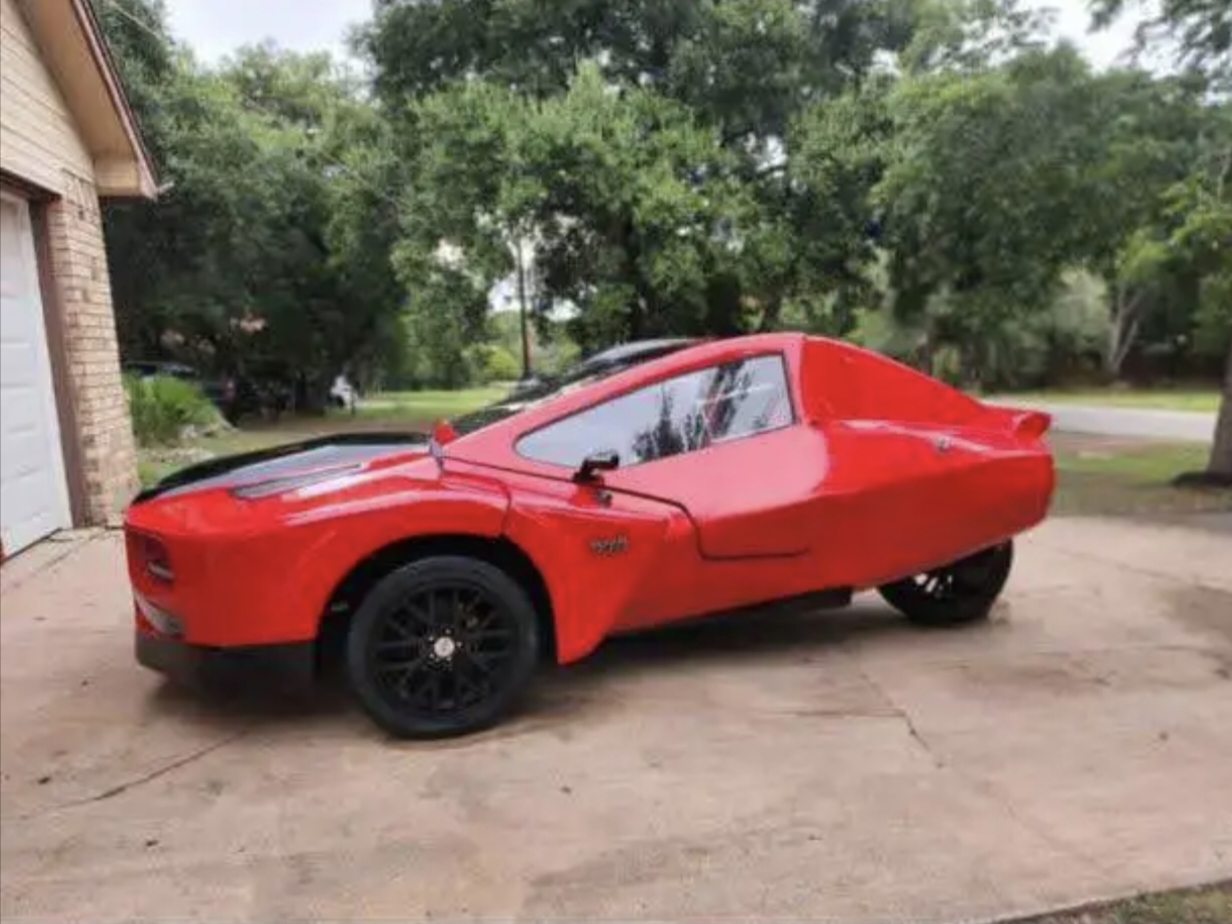
This car was first put up for sale a year ago in Arizona. The buyer of the vehicle moved it to Manchaca, Texas, and put it up for sale quickly. It’s still for sale a year later. Here’s what the original listing stated:
Selling this XR3 reverse trike for the widow of a friend who built it himself.
He was a Raytheon engineer who had built 2 of these previously. This is a full body reverse trike powered by 4 cylinder Kabota Turbo diesel engine. It has a 4 speed transaxle with rack and pinion front wheel staring. The suspension includes double air lift bags and coilover shocks. Hydraulic disc brakes, rear view camera and air conditioning.

Apparently, the original builder spent $21,800 putting this car together, and then drove it only 700 miles after completing it. The seller says that he has every single receipt from the build process, as well as a container filled to the brim with documentation and even a DVD about how the original builder put the car together.
What’s pretty cool to me is that this thing has heat and air-conditioning, which isn’t something that you often see in homebuilt cars. That body is pretty wild, though. It looks like the builder roughly followed the shape of the prototype, but it didn’t come out the other end nearly as rounded. I won’t dare to say whether this thing is pretty or ugly, but I will say that I admire what the builder accomplished, considering that Robert Q. Riley Enterprises did not produce a proper body for its kit car.


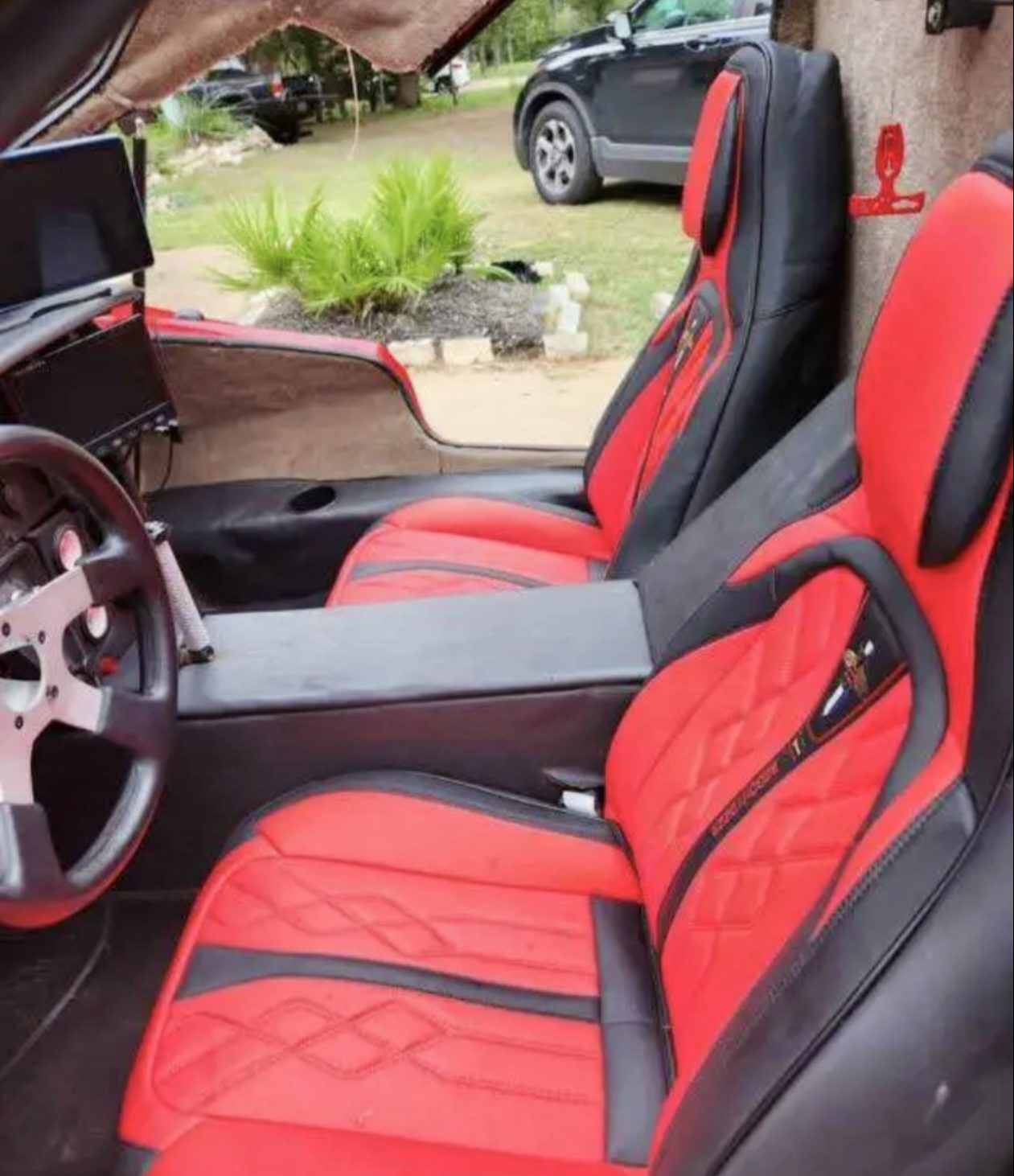
The DIY nature of the car continues inside, where there’s little in the way of refinement. You can see exposed fiberglass all over, the steering wheel isn’t much to write home about, and the transmission gearshift seems like an afterthought.
So, this thing is all kinds of weird and sort of off-putting, but I dig it. The seller wants just $6,500 for it, too, which doesn’t seem that bad!
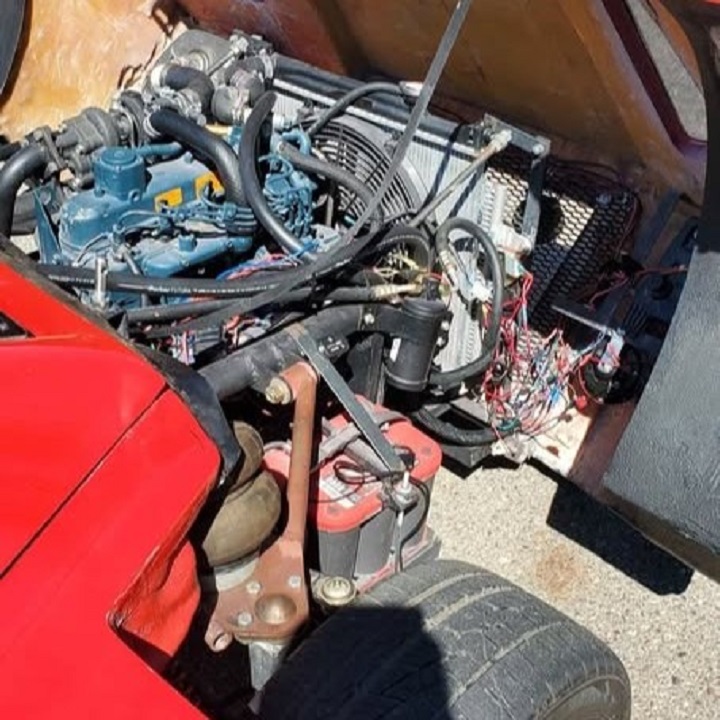
I think this car is the perfect example of the slang term “blursed.” It’s blessed and cursed at the same time. Cursed because, if you squint really hard, it’s sort of the poor person’s version of a Volkswagen XL-1. Blessed because, apparently, this car does get over 100 mpg. Riley sort of pitched the XR-3 as a cool way to save money at the pump and reduce your carbon footprint while having a ton of fun, and you know what? I believe it.
This is the kind of vehicle that everyone is going to stare at and everyone is going to ask questions about. Handling? Well, I suppose that’s going to be on the builder, but there’s still fun in building your own car and then trying to see if you can get it to do well over 100 mpg. If anything, I want to see more cars like these. They’re different, and that’s neat!

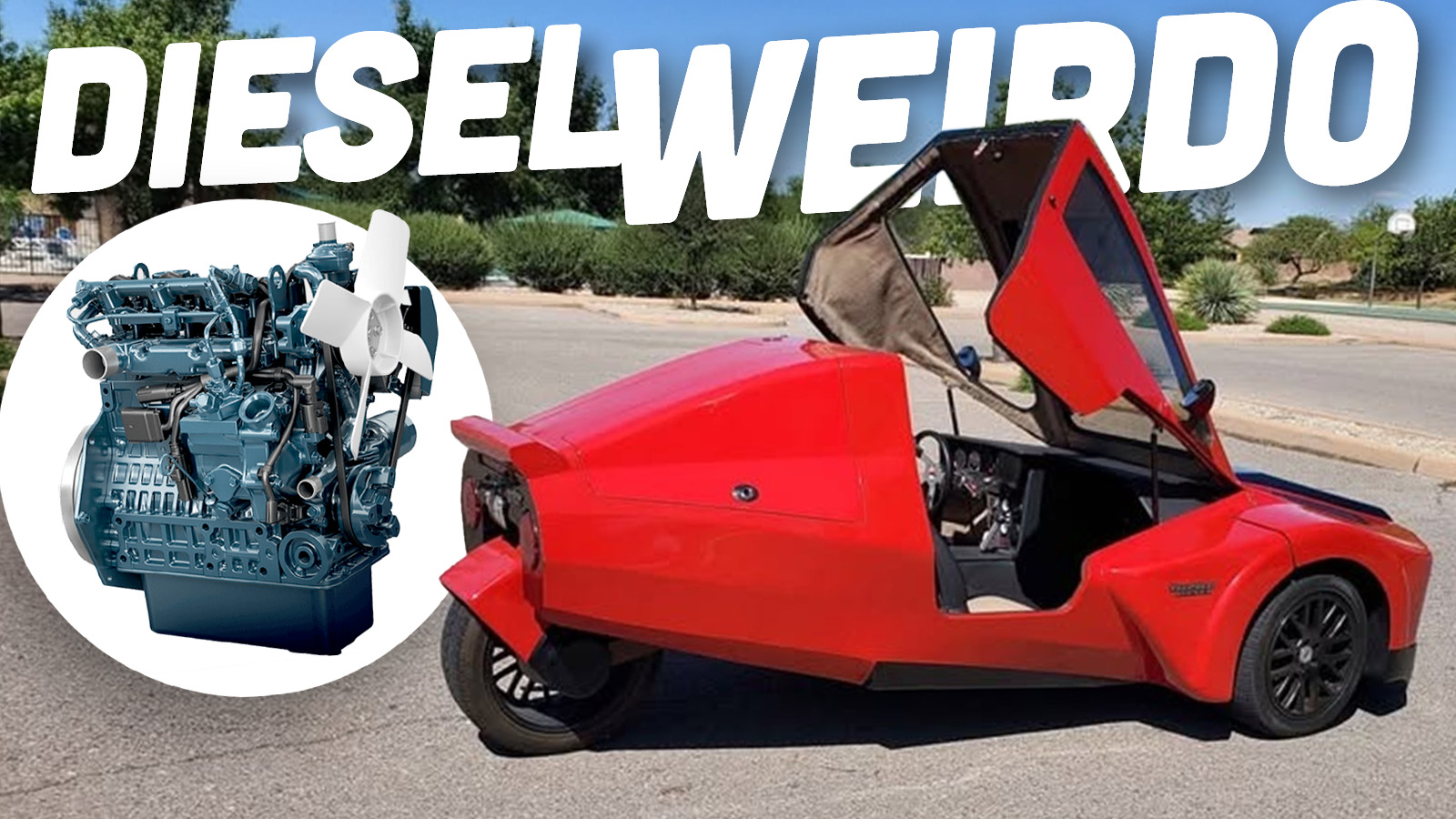




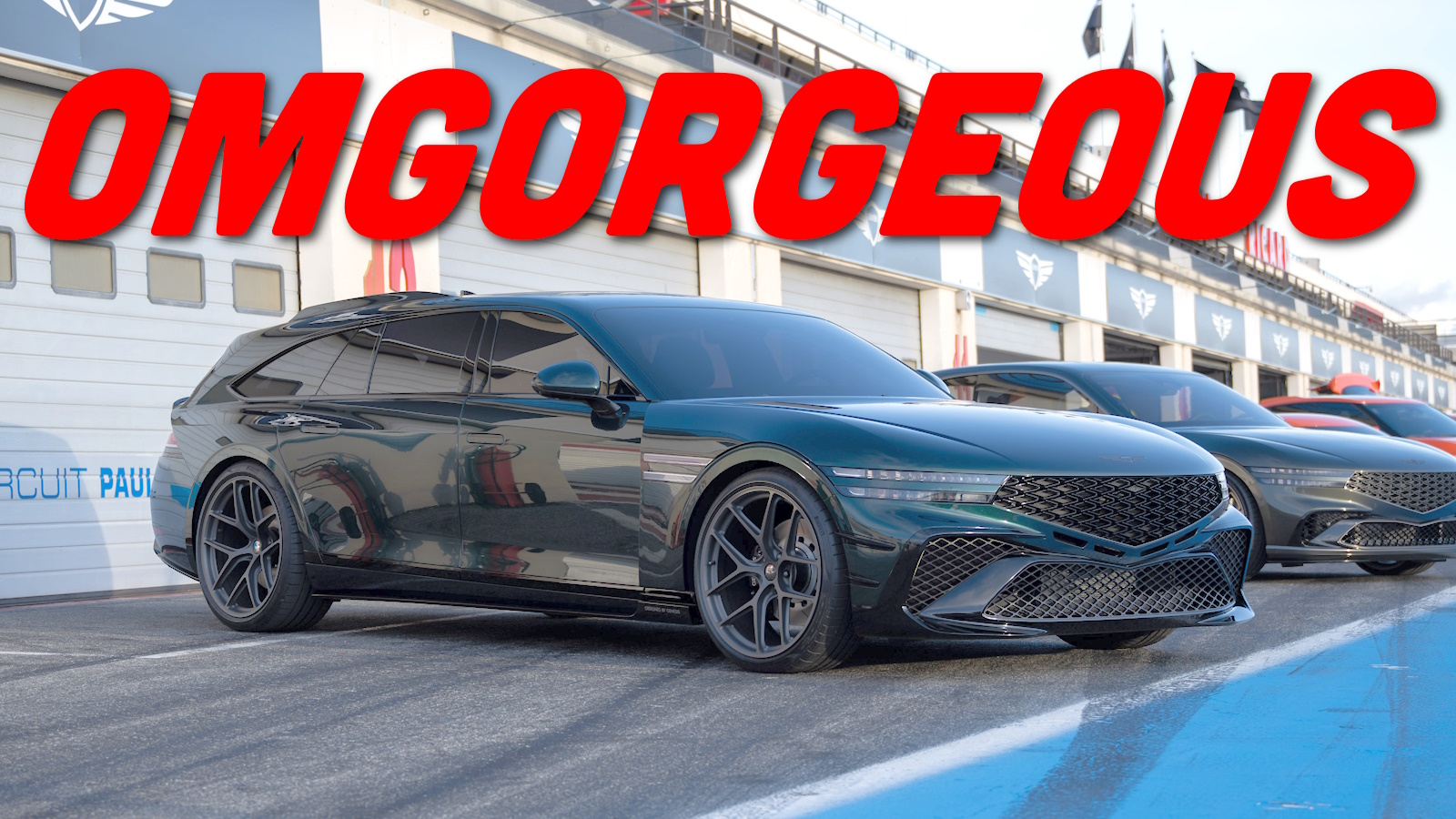


I would be highly surprised if the squared off buck tooth body on this one still netted that kind of mileage. But it is legal to drive and does give off 8 Bit Elio vibes. So it almost seems worth it to try it out.
The prototypes were largely cool-looking in a Blade Runner 2049 sense. Except these are all ground-bound.
It’s amusing that the original was set in LA in 2019. Fortunately, that dystopia is late to the show.
IMHO a diesel engine, without transmission, without gearbox, without drive belts and what not but connected to a generator (think alternator), directly connected to it, with a small buffer battery (perhaps as low as 5 kWh, perhaps the size of 3 regular lead acid batteries).. in a small car. Electric motor on the rear axle with a diff. DONE.
The diesel engine can be tuned to run at a constant RPM. You can’t rev it. It is there to produce juice for charging the battery and to provide power to the electric motors.
Because there is a buffer battery, the electric motors could be way more powerful than say a 15 hp diesel engine. Because the electricity could come from the battery. So if you want to go fast quickly – you can. The electric motor could be say 150 hp. Normally you only need 10-20 to maintain 60 mph on the highway. The diesel would just run around happily at its optimum rpm, perhaps 800 or so, producing the least amount of emissions and noise, while providing enough power to generate the required energy. If more is needed, more diesel would be injected, RPM would stay the same, perhaps it could increase to say 1200 or so. Think truck rev ranges (where 1800 is a lot).
Because of the small buffer battery the car could drive a small distance fully electric. Even a few miles would already be great to reduce noise when coming home or leaving. And the diesel could turn off when you’re in a traffic jam and the battery is full.
Diesel engine + generator + batteries could fit easily under the hood of a normal modern car. Think VW Golf 5 size. Electric motor under the car, rear wheel drive, differential. Instead of the drive shaft. Small motors aren’t large anymore. Another option would be two in-wheel motors if that would be cheaper/more feasible.
So you’d have ‘unlimited’ range. It would use an absolute minimum of fuel and it would run at optimal emission levels. It would be quiet when needed and fast enough for nearly everything except racing on a track. The tech is not special, the battery doesn’t have to be super compact and the best of the best, as long as it works and can fit with the small diesel generator under the hood. No front wheel drive so a lot of space to work with.
So at least 1300 hours, based on my experience with estimated build times on other significant car-related projects.
I dig it, but I’m weird, always liked the XL1, and drove a VW TDI for 23 years. If the aircon works, and you could actually register and insure it for use on public roads (unlikely in SoCal would be my guess) then six grand doesn’t seem so bad, even if you just used it for Cars & Coffee. No reason you couldn’t use it for errands too: seems like there might be room for a few bags of groceries in the back. But again: I’m weird.
I would bet a significant amount of money that this doesn’t get anywhere near the advertised MPG, and that my 300k miles 2000 honda insight could beat it… while having 2 airbags, AC, a subwoofer, and be faster with a higher top speed.
Looks even worse than something from an Aging Wheels video!
Nice Kubota engine, nothing wrong with that. Would love to use it for something fun myself, maybe stick it in an old VW Bug, just to piss off the purists.